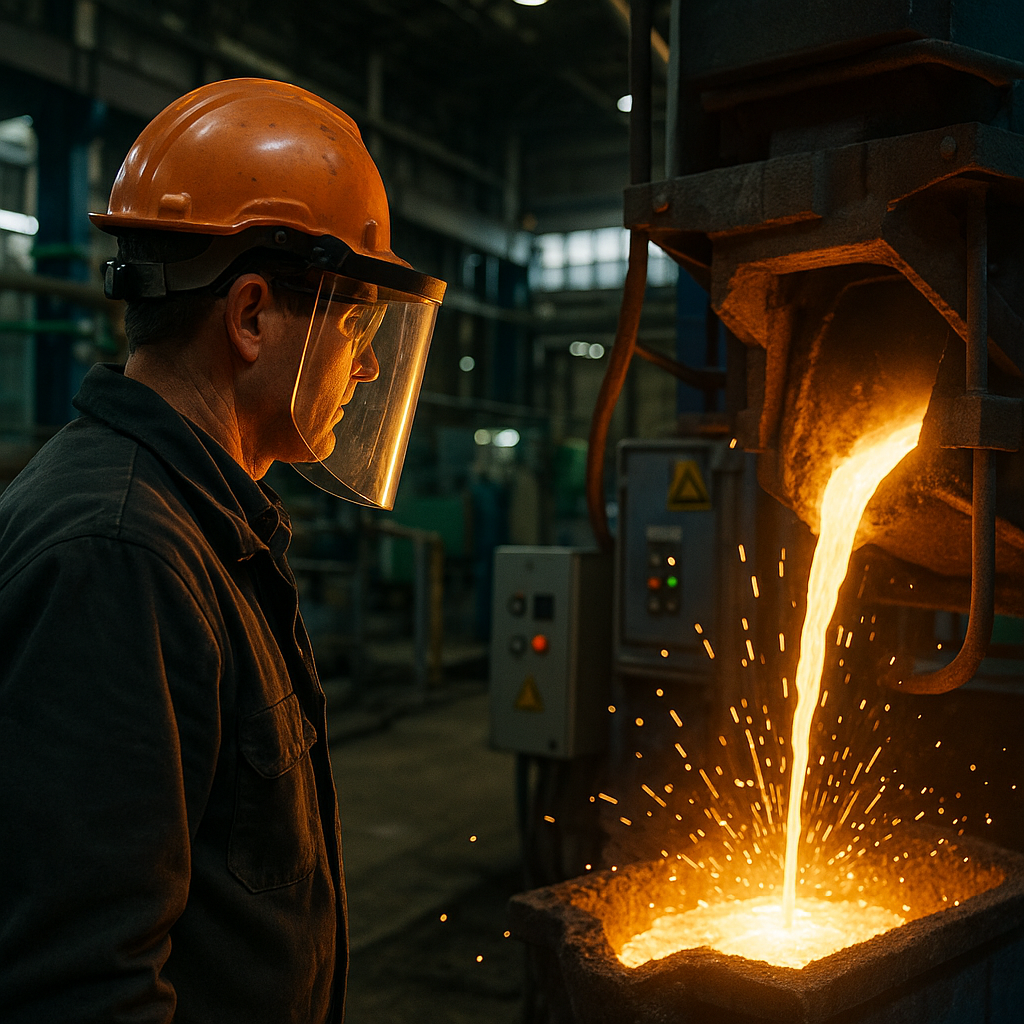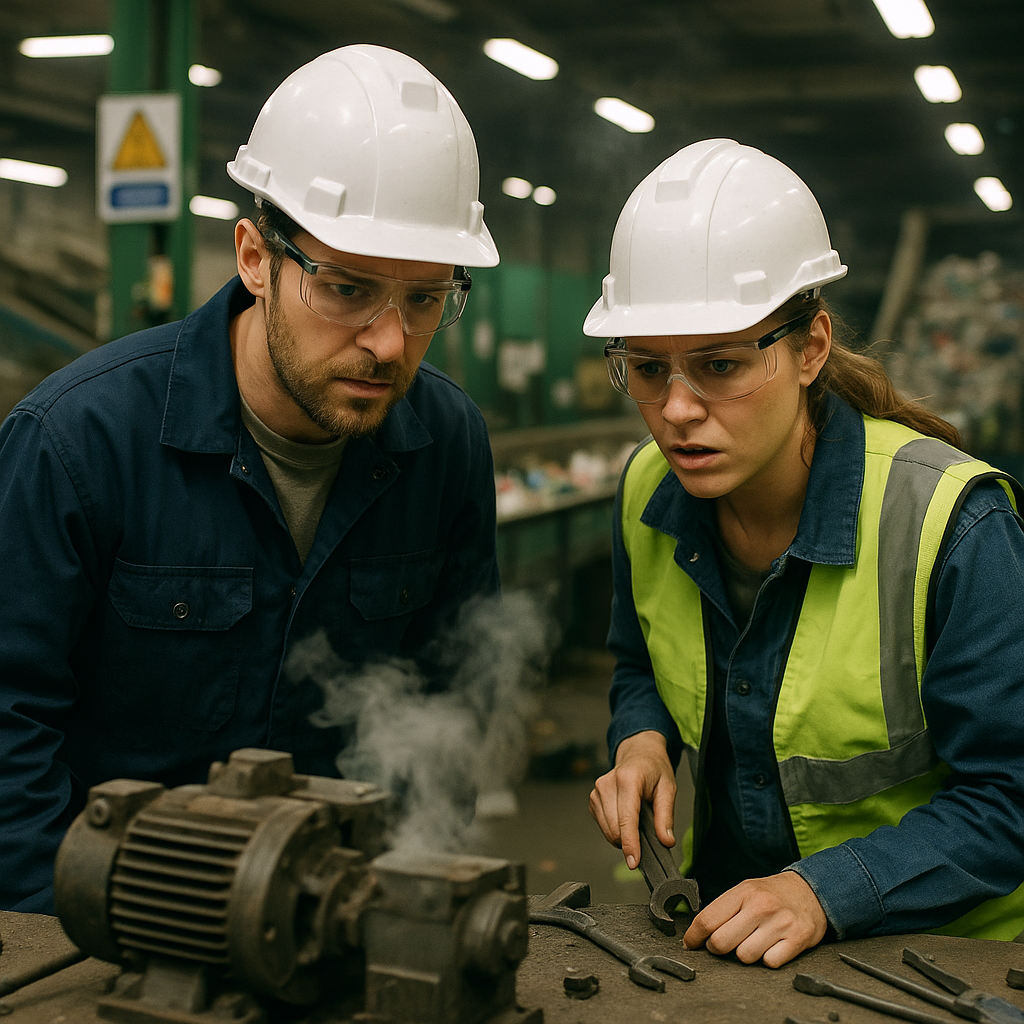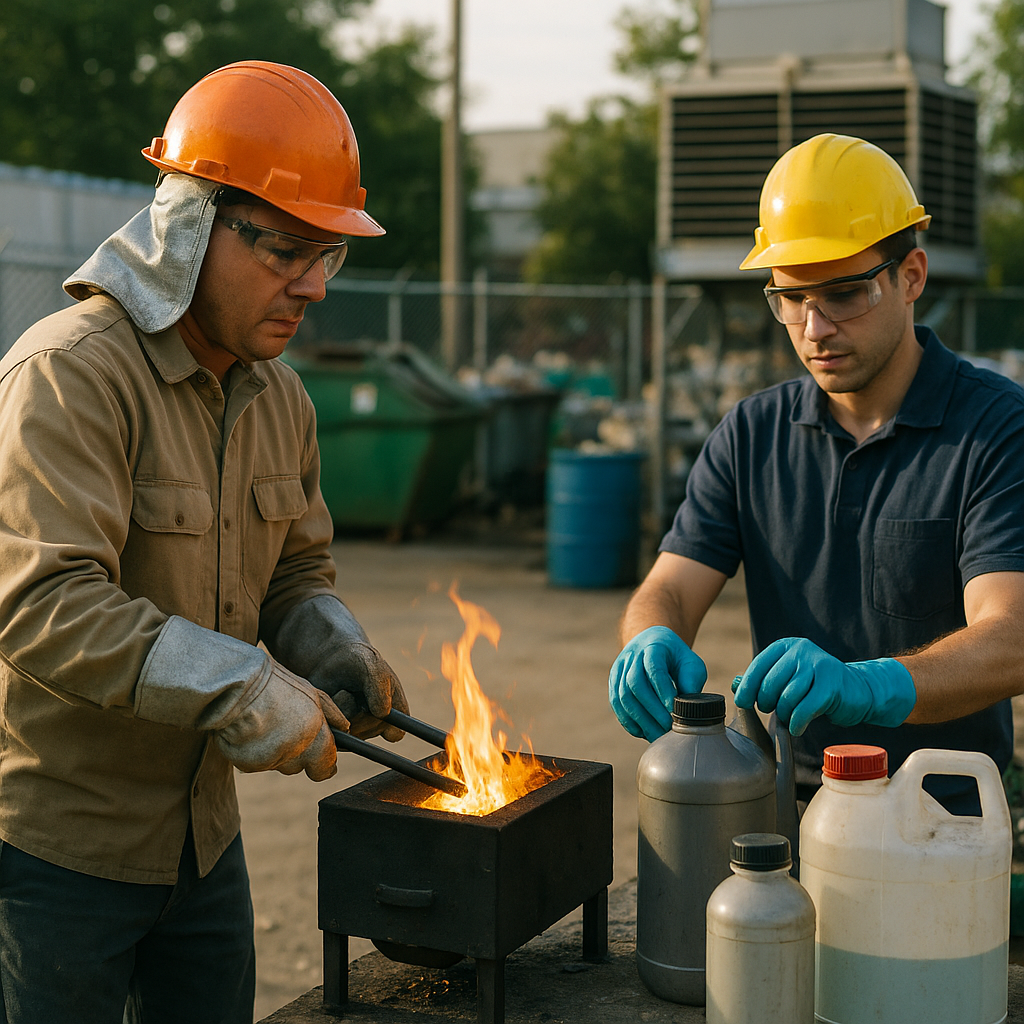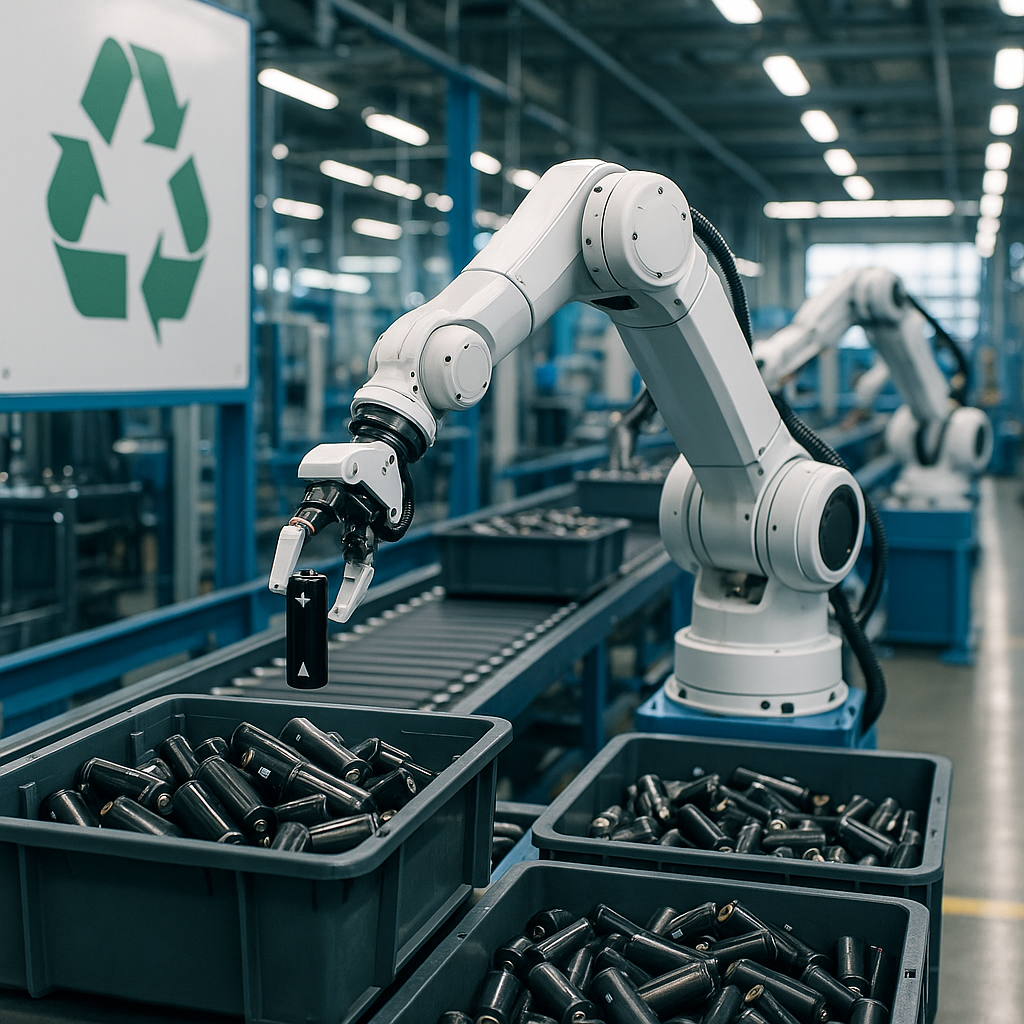5901 Botham Jean Blvd, Dallas, TX 75215
What is the Pyrometallurgical Recycling Process for Lithium-Ion Batteries?
September 29, 2025The global increase in electric vehicles and portable electronics has created an urgent need for sustainable battery recycling. Pyrometallurgy is a leading solution, utilizing high-temperature processes to recover valuable metals from spent lithium-ion batteries. This method converts end-of-life batteries into reusable resources through controlled thermal reactions.
At its core, pyrometallurgical recycling involves two main stages. First, batteries undergo thermal pretreatment at temperatures between 140-500°C, safely removing volatile components like electrolytes and breaking down organic binders. The second phase is smelting at significantly higher temperatures, typically 1400-1700°C, where remaining materials separate into a metal-rich alloy and slag phase. This intense heat enables the recovery of valuable metals like cobalt, nickel, and copper, which accumulate in the alloy for further refining.
A key advantage of pyrometallurgical recycling is its ability to handle mixed waste streams without extensive sorting or preprocessing. The process effectively manages various battery chemistries simultaneously, making it especially suitable for processing commercial battery waste. While traditional pyrometallurgical methods struggled with lithium recovery (often lost to slag), modern techniques now incorporate innovative solutions like chloride volatilization to capture this essential battery material.
What Are the Key Advantages of Pyrometallurgical Recycling?

Pyrometallurgical recycling is a vital process for recovering valuable metals from spent lithium-ion batteries, offering distinct advantages over alternative methods. This high-temperature approach efficiently transforms waste into resources, overcoming many limitations of other recycling technologies.
The process involves using high temperatures to recover and purify metals through controlled physical and chemical transformations. At lower temperatures, reactions focus on phase transitions and structural modifications, while higher temperatures drive extensive chemical reactions. These characteristics make pyrometallurgy particularly valuable for industrial-scale recycling.
Versatility in Processing Mixed Waste
An important advantage of pyrometallurgical recycling is its ability to process mixed waste streams with minimal sensitivity to input composition. Unlike other methods requiring careful sorting and preparation, pyrometallurgy can handle diverse battery chemistries simultaneously. This flexibility eliminates the need for extensive pre-sorting, saving time and resources.
The technology accepts various input materials without strict requirements for categories or size. This versatility is especially valuable given the growing diversity of lithium-ion battery chemistries, from LiCoO₂ to LiFePO₄ and complex ternary materials like NMC (lithium nickel manganese cobalt oxide).
Operational Simplicity and Efficiency
Pyrometallurgical processes feature relatively simple operations compared to hydrometallurgical methods. The straightforward process flow reduces complexity, making it easier to implement and maintain at industrial scales. This simplicity translates to higher productivity rates and more reliable operation.
The high-temperature reactions in pyrometallurgy occur at accelerated rates, allowing large treatment capacity. These faster chemical reactions result in shorter overall processing times compared to hydrometallurgical approaches, which often require lengthy leaching steps.
Reduced Chemical Consumption
Pyrometallurgical recycling significantly reduces the need for harsh chemicals. The thermal nature of the process minimizes acid consumption compared to hydrometallurgical methods, which typically require substantial amounts of concentrated acids for effective metal extraction.
This reduction in chemical usage not only lowers operational costs but also decreases the environmental footprint associated with chemical production, transport, and disposal. Although the process requires careful management of gaseous emissions, it generates less wastewater than hydrometallurgical alternatives.
Industrial Scalability
The pyrometallurgical approach excels in large-scale industrial applications. It has been successfully implemented by major recycling companies worldwide, including Umicore in Belgium with their Ultra-high-temperature smelting-technology (UHT), Glencore in Switzerland, and Accurec in Germany.
These commercial operations demonstrate the viability of pyrometallurgical methods for processing substantial volumes of spent batteries. The potential for industrial scaling makes this approach particularly attractive as the volume of end-of-life lithium-ion batteries grows with the expanding electric vehicle market.
Recovery of Valuable Metals
Pyrometallurgical recycling effectively recovers high-value metals from spent lithium-ion batteries, particularly cobalt, nickel, and copper. The process achieves high recovery rates for these materials, which represent a significant portion of the economic value in spent batteries.
Modern pyrometallurgical systems can be designed to recover multiple metal types simultaneously. When combined with secondary hydrometallurgical processing of the resulting slag, these systems can achieve comprehensive recovery of most valuable components from spent batteries.
Energy Efficiency with Advanced Technologies
Recent advances in pyrometallurgical recycling have significantly improved energy efficiency. Technologies like microwave-assisted heating enhance the efficiency of carbothermic reactions at temperatures exceeding 600°C. These innovations reduce energy consumption while maintaining the core benefits of pyrometallurgical processing.
Modern facilities incorporate integrated off-gas treatment systems that result in complete dust removal, minimal gas evolution, and elimination of volatile organic fractions. These improvements address many historical environmental concerns associated with pyrometallurgical processes.
What Challenges Does Pyrometallurgical Recycling Face?

Pyrometallurgical recycling, while effective for recovering certain metals, faces significant challenges. High energy consumption is among its major drawbacks. The process requires temperatures between 1400°C and 1700°C to smelt materials effectively, resulting in considerable energy expenditure. This intense heat generation contributes to a substantial carbon footprint, with emissions reaching up to 361 tons of CO2 per kilogram of recovered metal.
In addition to carbon emissions, pyrometallurgy produces significant quantities of toxic gases during operation. When batteries undergo high-temperature treatment, materials like plastic casings, separators, and electrolytes release hazardous compounds that require expensive capture and treatment systems. These emissions pose environmental and worker safety concerns, necessitating comprehensive ventilation and filtration infrastructure.
Material loss is another critical limitation. During combustion, valuable components like plastics and graphite from the anode are completely lost rather than recovered. Particularly concerning is the fate of lithium and manganese—two valuable battery materials—which mostly end up in the slag phase instead of being recovered, creating a significant gap between theoretical and actual material recovery rates.
The financial requirements for pyrometallurgical facilities present another hurdle. The specialized furnaces, emission control systems, and safety infrastructure demand substantial initial investment. Companies must weigh these expenses against projected recovery values, especially as battery compositions shift toward lower-cobalt formulations that yield less valuable metal outputs.
Finally, pyrometallurgical processes rarely serve as standalone recycling solutions. The output typically requires additional processing through hydrometallurgy or electrometallurgy to achieve the high-purity metals necessary for battery manufacturing. These supplementary refining steps add complexity, cost, and time to the overall recycling process.
While these challenges are significant, the industry continues developing integrated approaches that combine pyrometallurgical efficiency with complementary methods to maximize recovery rates. Some facilities now utilize the heat generated during pyrometallurgy to power other recycling processes, creating more energy-efficient systems. Others have implemented advanced technologies to capture and utilize gases produced during smelting, reducing both emissions and operating costs.
How Does Pyrometallurgy Compare to Other Battery Recycling Methods?

Pyrometallurgy is one of three main methods in battery recycling, alongside hydrometallurgy and direct recycling. Each method offers distinct advantages and challenges when processing end-of-life batteries. While pyrometallurgy effectively manages mixed waste streams, it has limitations in both material recovery rates and energy consumption compared to the other methods.
Pyrometallurgy: High-Temperature Processing
Pyrometallurgy involves thermal treatment at temperatures from 140°C to 500°C to remove volatile substances, followed by smelting at 1400°C-1700°C. This process generates cobalt, copper, and nickel alloys, and a slag containing lithium and aluminum oxides. The high-temperature approach makes pyrometallurgy relatively straightforward for processing mixed battery types without extensive sorting.
The main strength of pyrometallurgy lies in its flexibility. It can handle diverse battery chemistries with minimal sensitivity to feedstock composition, making it ideal for unsorted battery waste. This method also benefits from shorter reaction times and less concentrated acid use compared to hydrometallurgical processes.
However, the energy intensity of pyrometallurgy is a major drawback. The process requires substantial electricity or fuel to achieve high temperatures, resulting in significant carbon emissions. Metals recovered through pyrometallurgy frequently form alloys requiring further processing, and the method struggles to recover lithium, which typically ends up in slag or is lost through vaporization.
Hydrometallurgy: Chemical Extraction
Unlike the heat approach of pyrometallurgy, hydrometallurgy uses chemical leaching to dissolve and separate battery metals. The process starts by creating “black mass” from shredded batteries, then extracting valuable materials through chemical treatment. Modern hydrometallurgical methods can achieve over 98% recovery rates for copper, nickel, and lithium.
Hydrometallurgy offers better recovery rates for critical materials like lithium, which pyrometallurgy often loses. It also operates at lower temperatures (60-90°C), reducing energy consumption by about 70-80% compared to pyrometallurgy, leading to a smaller carbon footprint.
Challenges in hydrometallurgy include managing environmental risks from chemicals used in leaching and extraction, such as volatile organic compounds and potentially corrosive substances. The process also creates wastewater requiring treatment and can be complicated by varying battery chemistries, which may necessitate adjustments to extraction protocols.
Direct Recycling: Preserving Component Structures
Direct recycling is the newest approach among the three methods. It focuses on physically disassembling batteries to recover components with minimal chemical or thermal transformation, especially preserving valuable cathode materials. This method retains the functional structure of cathodes by supplementing lithium salts into lithium-deficient materials to restore performance.
The main advantage of direct recycling is its energy efficiency, using 50-70% less energy than pyrometallurgical methods. It also preserves the original cathode structures, retaining their economic value and reducing the need for extensive reprocessing. With fewer downstream processing steps, direct recycling minimizes yield losses and can produce higher-quality materials with fewer impurities.
However, direct recycling technology is less developed for commercial-scale operations compared to pyrometallurgy and hydrometallurgy. The process is currently more labor-intensive and often requires careful sorting by battery chemistry, limiting its scalability. Its effectiveness also varies by cathode type, working better with some chemistries than others.
Hybrid Approaches Gaining Traction
To mitigate the limitations of individual methods, many commercial recyclers have developed hybrid processes that combine elements of pyrometallurgy and hydrometallurgy. These approaches typically start with moderate-temperature treatment (like reductive calcination at lower temperatures than traditional pyrometallurgy) followed by hydrometallurgical leaching and extraction.
Some companies have implemented such hybrid systems, using reductive calcination pyrometallurgy operating at lower temperatures than conventional smelting, followed by hydrometallurgical processing. This approach has shown promising results, significantly reducing greenhouse gas emissions and water consumption compared to traditional pyrometallurgical methods.
Recent industrial-scale analysis indicates that these hybrid approaches can cut energy consumption by up to 77% and CO2 emissions by nearly 58% compared to conventional refinement of mined materials. They also address pyrometallurgy’s weakness in lithium recovery while maintaining its ability to process diverse battery types.
What Does the Future Hold for Pyrometallurgical Battery Recycling?

The pyrometallurgical recycling industry is set for significant growth as global use of lithium-ion batteries accelerates. This expansion is fueled by the rising demand for efficient recycling solutions to manage the increasing volume of spent batteries from electric vehicles and consumer electronics. Research initiatives are focusing on improving metal recovery efficiency, particularly enhancing lithium reclamation rates that have traditionally challenged pyrometallurgical methods.
Environmental sustainability remains a crucial focus, with innovations such as integrated off-gas treatment systems addressing past emission concerns. These technological advancements are making pyrometallurgical processes more environmentally viable while maintaining their capacity to handle mixed battery feedstocks. Economic aspects are also improving through process optimization and the development of more efficient smelting technologies that reduce energy consumption and operational costs.
As battery recycling evolves, pyrometallurgical methods will likely continue to play an essential role in the circular economy of battery materials, particularly when integrated with approaches like hydrometallurgy in hybrid systems. This combination leverages the strengths of each method to maximize resource recovery and minimize environmental impact. Contact Okon Recycling at 214-717-4083 for your recycling needs and support the sustainable future of battery materials.
